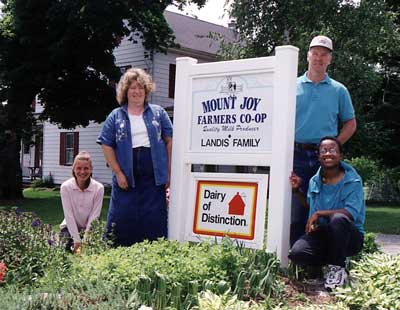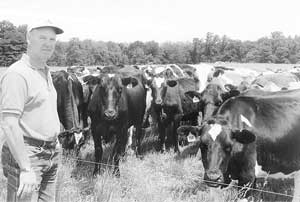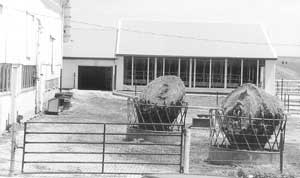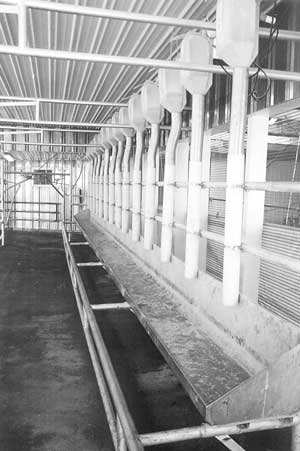Arden Landis of Lancaster County
By Dieter Krieg

Conventional dairy farming is out at Green Pastures Farm in Lancaster County. Operated by the Arden Landis Family. The methods employed to produce milk profitably are somewhat uncommon, to say the least. Radical and surprising are two other adjectives that describe the operation. Left to right are Kristie, Caroline, Arden and Debbie.
KIRKWOOD, Pa.- Simple and profitable sum up the management style at a 130-acre farm operated by the Arden Landis family. The approach is sometimes radical, often surprising, and consistently effective. Arden, who didn’t get into the dairy business until he was 35, is not your ordinary dairyman. He’s not afraid of work; but at the same time, he doesn’t believe in doing chores that really wouldn’t have to be done. That’s why he doesn’t use a barn. Barns, he says just create more work and unnecessary expenses. His herd seeks shelter out under the trees and the sky. Even during the coldest months of the year, Arden says there’s nothing easier than managing dry cows and bred heifers outdoors. “That barn over there is a monument to the past,” he said of the structure that he was still milking in less than a year ago. But not anymore. Arden’s new parlor, which was imported from Ireland, is another radical idea. It is so basic and open that there’s no feeling of enclosure or confinement anywhere. Extremely simple in design, the “swing-16” system cost Arden less then $50,000, which included installation. Adding construction and remodeling costs, he figures a facility like his can be built for under $100,000.

ARDEN LANDIS says he never had it so good has he does now. His cows, he points out are healthier than ever and production is profitable, although not yet the highest. The milking string receives 6-7 pounds of grain per day, which is fed in the parlor. Wrapped baleage from his own fields is also fed, as is rough, dried hay which he purchases. Heifers receive no grain after they’re a year old ... only to be resumed a few weeks before freshening.
“Milking in there is like taking candy from a baby,” he declared happily. Some other noteworthy management differences that you can find here at Green Pastures Farm include:
1. Minimum field work and equipment inventory.
2. Smaller cows, with 900-1000 pounds being considered ideal.
3. No corn silage in the feeding program since 1995.
4. As many as four bulls running with the herd -- a bull for every 15 to 20 cows.
5. Minimum grain feeding and no soy-bean meal whatsoever since 1997.
6. Perimeter fences around the entire farm.
7. Grain is fed in the parlor; the same amount every day to every cow.
Arden figures he’s grossing approximately $1200 per acre during the growing season, managing the way he does and he doubts that the profitability can be matched by more conventional crops. He admits that he doesn’t have the highest production. On the other hand, he doesn’t have the expenses that many other dairymen have and he’s pretty sure that he has a herd of cows that will stay around longer … which also adds dollars to the bottom line. He figures his culling rate to be under 10 per cent, with many of his cows staying in the herd for four or more lactations
By now you have figured out that Arden is a grazier. What you may or may not suspect is that he is also a producer for the organic milk market. That distinction has required him to learn a whole new realm of management practices. It took him four years to become a certified organic producer, he says, noting that such a time span is necessary for two reasons: 1. Fading out the physical residues left over from conventional farming and animal husbandry, and 2. there’s a learning curve involved.
Although Arden is a relative latecomer to the world of dairying, he has had varied experiences, including several years with more conventional practices such as tie-stall barns, field work, TMR’s and high-producing cows. It was under his watch, for example, that an Excellent Rotate daughter produced a record of over 40,000 pounds of milk in one year. And the herd average went from 20,000 to 25,000. But he believes he has found something even better now. Dairying the way he does is less stressful on the family and healthier for the cows, he says. The inspiration to turn his herd out to pasture came when he learned of how much better some other dairymen did when they switched to grass-based dairying. In one case, he remembered, the man was close to bankruptcy, and the low-input management style saved him.
Arden believes in the low input concept, but not when it comes to soil fertility and producing high quality forages. “That’s where it all starts,” he emphasized. To that end, he is constantly eager to learn new information about soil fertility, forage crops, grass species and the like. More than once, he has found even 100-year old agronomy and forage books to be of value in his program. He seeks out grass species best suited for his soil and use, saying that re-seeding pastures is usually not necessary unless you want to introduce new species with improved nutritional qualities and/or palatability.
“One reason I like farming is that it’s a continual learning experience,” the middle-aged dairyman said enthusiastically. “I read a lot and attend conferences. That’s what makes it fun.”
Arden’s wife, Caroline shares his love for the farm, despite the fact that she did not grow up on a farm either. Both she and Arden are Montgomery Countians, where the rural lifestyle is getting evermore hard to maintain, let alone find. Caroline says she had a strong desire to live on a farm, but can’t exactly explain why. “It was just there,” she smiled. Then she added: “I do like the openness and it’s a good place for the family. Plus Arden and I enjoy working together.”
Being able to manage their (rented) farm together as a family was the goal Arden had in mind when he got into the dairy business and he has not veered away from it. He prefers not to have to manage employees.
However some outside help shows up occasionally. Much of the field work, for instance, is hired out. “I would rather pay someone to come in here for a few hours to prepare my fields for seeding than to have to keep a hired man busy and make equipment payments,” Arden reasoned. Similarly, someone is contracted to haul the slurry out of the recently constructed manure lagoon that collects the run off and manure from the parlor and barnyard.
As for the manure from the barnyard and calf pens, it’s stored for months at a time in a covered pit, left to rot, and can be hauled out in a single morning, with the help of a neighbor and his tandem-axle spreader. Arden sees no need to invest in a manure spreader of his own.
Two of the field chores Arden retains for himself are seeding and harvesting, although he gets some help there too. To save money, he gets the seeding done with a rented seeder, rather then one of his own. He does have his own harvesting machines however. A custom operator comes to the farm and wraps the grasses and legumes for baleage.
But first and foremost with his harvesting program of his own, more that 100 self-propelled, 4-legged choppers. He directs them from paddock to paddock every couple of days and in the fall they are allowed to run over the entire farm. All of the fences are permanently in place.
This concept is also a big help in keeping manure spreading expenses to a minimum. After all, his cows, heifers, and bulls have already taken care of most of it on their own as they walk the fields and pastures.
“I think installing a perimeter fence around the entire farm is something a lot of dairymen could do,” Arden suggested, noting that it allows for so much flexibility in management, not to mention savings. He’s sold on the idea. “You can do so much more if you have perimeter fences,” he declared.
A confirmed grazier, Arden figures on never having to milk more than 100 cows. That’s a good herd size to maintain the soil’s fertility, he reasoned. Of the 130 total acres in the farm, 100 are devoted to forages, 20 are in permanent pasture and the balance is woodland.
With the new swing-16 parlor, it will take less than 90 minutes to milk 100 cows. He is thrilled with it. Positively thrilled. To keep his costs down, he went for just the basic model, he explained, but if one so desires, the Dairymaster can be purchased with a lot of refinements such as automatic take-offs and electronic measuring devices. He didn’t figure that he would need them and isn’t disappointed that he omitted the “bells and whistles.” The information he gets once a month from DHIA is sufficient, he noted.
During this time of year it is not unusual for him to have cows milking over 100 pounds per day. Some of them finish with 20,000 pounds or more for lactation, he reported. His somatic cell count usually runs between 200,000 and 300,000; last fall it dropped to a low of 150,000. “The organic milk market requires us to always have our SCC under 400,000,” he pointed out. Most mastitis flareups are very successfully treated with natural remedies, Arden noted further, since more conventional medical treatments are disallowed.
“We are inspected for compliance,” Arden assured. Inspectors come around to see receipts for feed purchases, for example, since only certified organic feedstuffs can be fed. And inspectors want to see what’s in the medicine cabinet. Further, they want documentation of how many cows are (and were) milked. Arden markets his milk through Mount Joy Farmers Cooperative, which in turn delivers it to a plant that’s authorized to package it with the Horizon organic milk label.
While this style of dairy herd management takes some getting used to, Arden is pleased with it. “I feel that grass-based milk production is the most profitable enterprise for me, especially since I’m a certified organic,” he commented. “We are also striving to go seasonal. That goes together so well with cows on the pasture.”
“We don’t even have a nutritionist,” the innovative Lancaster County dairyman continued, “My feeding philosophy is simple: We have to meet the cows dry matter intake requirements first, then her energy needs, the last thing we’re concerned about is her protein needs. We feel we can do this through grazing, while also routinely offering some rough hay and feeding six to seven pounds of grain per head per day.”
Lower producers are fed the same amount of grain as higher producers, and it’s all handily done in the parlor with the pull of a lever. “We don’t believe in cutting the grain back when production drops because the cows can use the grain to build body reserves and maintain proper conditioning,” Arden explained. He likes to see his cows in good shape. “They do really good,” Caroline chimed in.
The cows file into the parlor and stand at a 70-degree angle. There are no hard or sharp turns for them to have to get used to, Arden pointed out. The milkers are attached from between the legs. Milk-outs are virtually unbelievable, he reported, which is probably due to a combination of things, including pulsation, liner style and the weight of the individual units. “The claw itself is light, but with these heavy shells, each unit weighs seven and a half pounds,” he commented. “It makes for great milk out and we have eliminated slow quarters altogether. We put the milkers on and never have to adjust them. And we have noticed that we can’t over-milk the cows because of the design of the inflations and the complete rest phase that they offer.
The pulsation system for the 16 units is sequential in that no two units are ever pulsating at the same time. Also different is the suction, which is on all four teats at once, rather than alternating back and forth between front and rear quarters. Yet another difference with the milking system is the variable speed milk transfer pump, allowing for a slower, yet steady pumping of the milk to the bulk tank. Along the way is a tiny pre-cooler. “We don’t need a big one, thanks to the variable speed pump, Arden noted.
“This is so much nicer than the way we used to do it,” he continued. Our adopted daughter, Debbie, and I used to get up at 3:15 to get the cows in. We chained them in their stalls, fed them, and got the milkers ready. Then we had to scrape the alleyways before I started to milk, and Debbie went back to bed. I ran six units with 65 cows in four rows of stalls. At 5:30 Caroline and our niece, Kristie, would join me with the chores. By 6 or 6:30 we would be all done and I would be so tired that I usually took a nap after breakfast.”

The new milking parlor is inside the shed straight ahead in the picture at left. Arden made use of an existing building, doing some remodeling to accommodate the facility. Part of the building is new, extending out over what used to be the feed bunk area. The old barn, which is no longer in use, is partially visible in the left of the photo. Rough hay is always available to the cows, as shown.
“Now I hardly ever take a nap anymore. I can sleep in until 4:30 and am milking by 5:15. An hour later, I’m done. That’s with 85 cows; we are still working our way up to 100. Anyway, we have really lowered our labor requirements with this new parlor.”
Spring heifers and dry cows are allowed to come through the parlor to help get them acquainted with the routines.
“Our plan is to milk no more than 100 head. We will freshen what we need in the spring and any additional animals will be sold as springers. This is a good herd size for us. When you expand the size of the herd, you end up having to expand a lot of other things too, such as your feed and manure storage, maybe a bigger bulk tank and a new parlor, extra labor requirements and so on. We were mindful of it and wanted to avoid all that.”
As unique as most everything is on this farm, the breeding program fits right into the collection of uncommon management practices. A.I. is used extensively, but it’s not necessarily the familiar sires that many other dairymen are using. Arden prefers New Zealand Friesian bulls for their smaller stature. In his opinion, the smaller size is also more efficient. Furthermore, he has done a lot of cross-breeding, with a Holstein-Jersey cross being his favorite.
Again, it’s the size of the animals that interests him. Nevertheless, he also has some purebred Holsteins in his herd and the Ayrshire, Brown Swiss, and Milking Shorthorn breeds are also represented in some way or another.
A.I. is used during the first three weeks of the breeding season, but if the cows don’t settle, there’s always a bull around. In fact, Arden will run as many as four clean up bulls in the same pasture at the same time. “A little competition gets things done,” he grinned. The fact that he may not know which bull sired which calf does not bother him. “Getting cows breed back is what’s important,” he declared. Heifers are bred naturally by Jersey bulls. Realizing the potential for inbreeding with so much pasture breeding, Arden says he manages to prevent it.

Calves are always born outside, although an indoor box stall is available right next to the new parlor. Furthermore, Arden is giving some thought to remodeling the old barn for maternity and calf pens. Nevertheless, he maintains his strong preference for raising the animals outdoors. “The moment I open that barn up, I create two things for myself: Work, and additional expenses,” he proclaimed. “That’s why we prefer to house our cattle outside, with the exception of young calves. But once a calf is weaned, it’s not likely that she will see the inside of a building again until she walks into the parlor two years later.
The outdoor environment is home to the young stock during all seasons of the year.
“The north and west sides of this farm are completely surrounded by woods. I can take hay out to them, and I also make it available here in the barnyard buts it’s very rare that they come up here to stay. They like it outside and they do very well. Cows can adapt well to cool, crisp weather.”
“But the weather during any time of year can also create a lot of variables and fluctuations that a conventional dairyman doesn’t have to deal with. Any time it rains, it presents a change in forage quality,” Arden continued. While his physical labor requirements and machinery investments are reduced when cows are kept outside, he says he has to use his head a lot more to manage for the results that he’s looking for. “A guy with buildings isn’t affected the same way by the weather as I am.”
Profitable production and negligible herd health problems tell him that the system is working. “Our cows are definitely healthier,” Arden confirmed. “Out of the nearly 70 cows that calved so far this spring, only two needed assistance. And we have had no cases of milk fever or ketosis. We haven’t had any displaced abomasums since 1997.”
Although he needs to pay close attention to all aspects of herd health, one area that Arden pays particularly close attention is the feet. Hoof trimming isn’t needed so much due to the cows wearing their feet down on pastures, but any problems such as infections or embedded stones require immediate attention. “We have to keep the feet and legs in shape,” Arden affirmed.
Walking out to the pasture, he takes some pleasure in seeing the cows grazing leisurely. They are all tame and come to the fence to be petted. Milking time is still several hours away. They are enjoying themselves, you can tell. And so is the Landis family. Dairying has become so much easier for them.